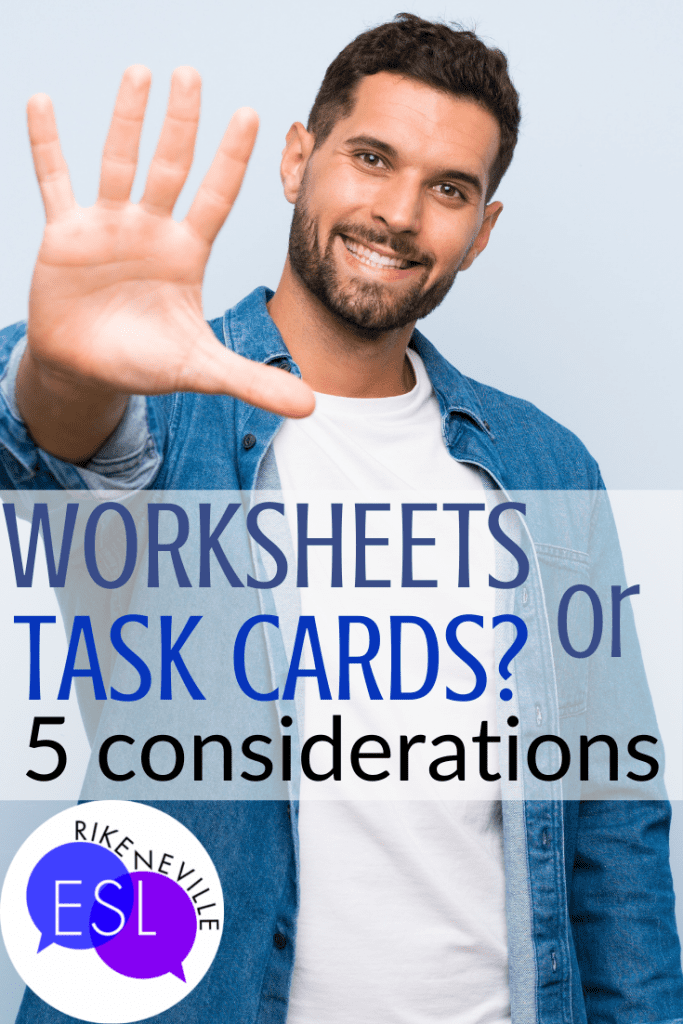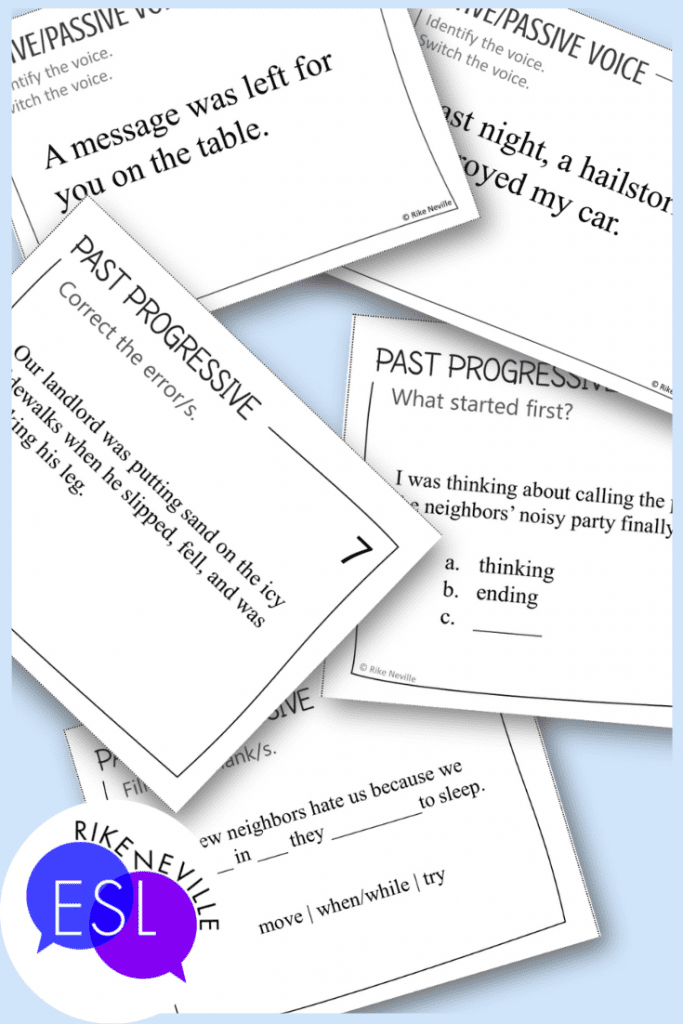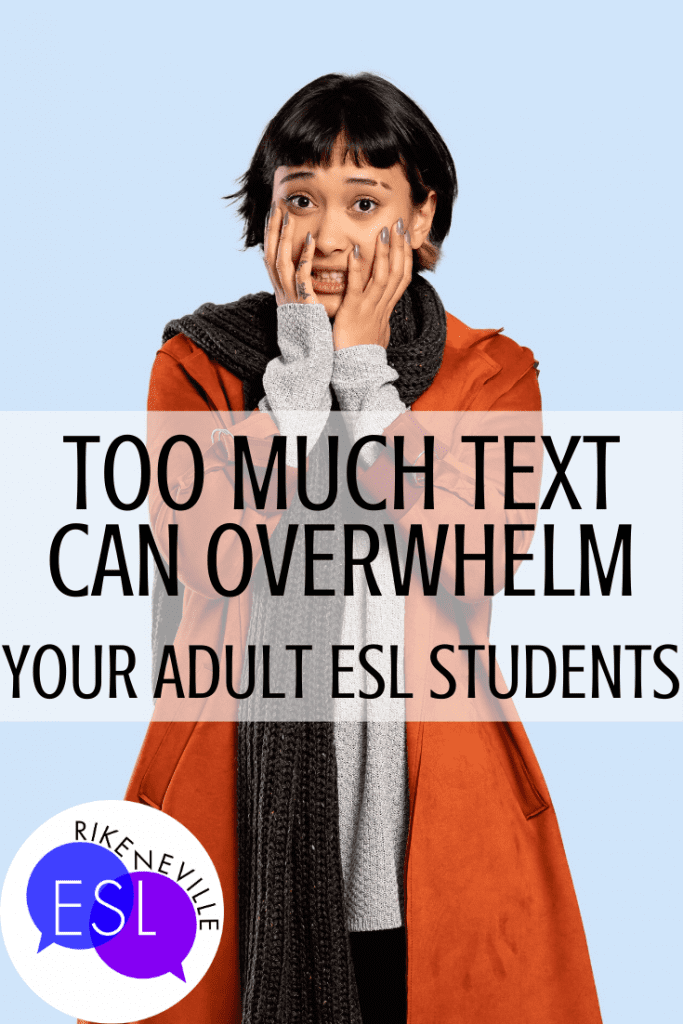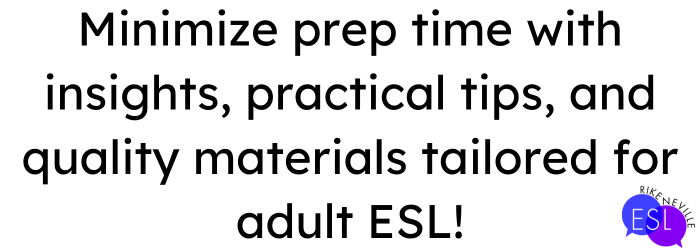
They’re all the rage in elementary through high school, but most adult ESL teachers have never heard of task cards. The cutesy clipart and thick colorful borders aside, task cards are a fabulous tool to use with adult ESL students. (And you can get them without that clipart and busy borders.) The first time I ever saw task cards, my brain started humming with the possibilities. I just love a resource format that is versatile, don’t you?

What ARE task cards?
Task cards are bite-sized tastes for students to practice a specific skill. Rather than teach a new concept, they reinforce what teachers have already taught or introduced to their students.
What makes task cards different from a worksheet?
With task cards, teachers have the freedom to have students all over the place. They might be moving around the classroom, throughout the building, or even going outside. Worksheets often pin students to their seats, which might be necessary if space and time don’t permit movement. Plus, when your students are up and moving around, it’s a great deal easier to discreetly monitor them and take notes on what they struggle with and what might be too easy for them.
When is one format more appropriate than the other?
I like using both task cards and worksheets. Once I learned what task cards are, I knew I’d want to use them often, but I could also immediatley see that sometimes, worksheets would be the better option. Truly, each has its pros and its cons, but sometimes one is the better choice. How does one decide which is best?
Five considerations to take into account.
#1 How’s the weather? (No, seriously!)

Rainy days are generally worksheet days as students are rarely coaxed into be gregarious and prefer to work quietly. Sunny days with beautiful weather? Task cards are scattered outdoors so that we can all enjoy the fresh air. Students are also more likely to talk a great deal more, so moving outside makes me a better neighbor to another class that might require quiet.
#2 How energetic are they?
If they are already super hyped-up because of a sports event (for example), I’ll choose worksheets to help everyone calm down and focus more. If they’re dragging, task cards are my choice because I can get everyone up and moving.
#3 Is time of the essence?
Limited time? Task cards all the way! It’s so easy to have students do a few. If all they see are a few, they don’t end up with that feeling of being given busy work simply to fill the time.
When they are given a worksheet but not the time to complete it, they might feel like it wasn’t important to begin with OR feel stressed that they couldn’t do it all.
Another aspect of time is MY time. Do I have TIME to make copies of all the worksheets I need, or is it easier to whip out a set of pre-made cards that I’ve used in the past with another class? That they are reusable is one of my favorite time-saving aspects of task cards.

#4 How much physical space do you have?
If I have lots of space for everyone to move around or can utilize space outside the classroom, I LOVE using task cards. The groupings and set-ups become almost limitless. But I’ve often taught in extremely cramped conditions, and worksheets are much more suitable then.
By the way, here’s a fun way to use task cards that gets your students moving around. Attach a card to a headband and have each student wear one. As they walk around reading and answers the task cards on their classmates’ headbands, they also have to ask each other’s names. Instead of writing the number of the task card, they write the name of the student wearing the task card.
#5 How much talkativeness do you want to encourage?
When I have a class that LOVES to talk to each other and work together, task cards give them that interaction they crave. On the other hand, if I know the class next door will have a test or listening exercises, I’m more likely to choose worksheets to help keep the sound down. What about those classes where they just DON’T talk to each other? Task cards aren’t going to change personalities, so while I might employ them now and then, I’m far more likely to use the worksheets they are more comfortable with.
So just what is it about task cards?
Task cards instill a sense of can-do.
One of the biggest reasons my students report a preference for task cards is the feeling of being motivated vs. overwhelmed. Imagine you are learning another language, and you look down at your desk and see a full-sized page covered in text.

Did your mouth just get dry?
Now imagine instead a card with only one question on it.
That card with the bite-sized task will give your students more confidence in tackling the question than a worksheet full of questions would. They might end up answering the same number of questions as they would have on a worksheet, but with each question presented one at a time, students are far less likely to feel like they’re drowning and shut down.
It’s not just the foreign language aspect.
When you teach adults, you are teaching people who have a myriad of responsibilities outside of the classroom that they can’t just stop thinking about merely because they walked through your door. With their minds already going in a million directions at once, a traditional worksheet covered in text is more likely to trigger anxiety or a brain freeze than a can-do attitude. Task cards break everything down into more manageable chunks.
That task card sets can be used repeatedly, pave the way to more group work, are easily gamified, and make assessment quick and easy are also valid points in their favor.
Task cards make sub plans a breeze.

You know how it’s so much easier to just teach while sick instead of taking time for self-care? Who wants to spend all their free time creating special lesson plans in advance just to be able to attend their brother’s wedding? Make them yourself or buy them. Start now. When you have a good library of task cards, they are invaluable for the substitute who has to take over because you’ve come down with food poisoning.
Just declare a day of enrichment and allow students to pick and choose what they want to practice while the substitute supervises and checks answers. You won’t need to create those special lesson plans because everything the substitute and your students need will be right there. Oh, and you know those days when you lose your voice? This can SAVE you.
What does using task cards in a classroom look like?
Think differentiation! As you build up your library of sets, you make it easier and easier to
- Provide enrichment for students who have already mastered a concept that you need to teach the rest of the class.
- Give individual or groups of students a challenge or further reinforce a concept or skill that they are weak in while you are working with other students.
- Allow students to choose what to focus their attention on. Sometimes they want intensive practice, but sometimes they’re already drained from life outside the classroom and prefer something lighter.
Task cards that students can share and work on individually or in groups help you meet everyone’s needs. Nobody ever gets a class of students whose skills, strengths, and weaknesses are perfectly matched, and trying to provide individualized instruction to everyone at the same time can be a nightmare. Solid sets of concept and skill-specific task cards make it more manageable.
Not convinced? Task cards are a cinch to gamify!
Here’s how to gamify your task cards.
You can add task cards to almost any game out there. Use them with:

- Simple board games where everyone has to draw a card and answer it before rolling. If the answer is correct, they can roll the die and move that many spaces. If the answer is incorrect, they miss that turn.
- Card games: With UNO, you can add the rule that whenever a student plays a draw two or a draw four card, the next player has to draw two (or four) task cards, split them with another student of their choosing, and answer the questions before proceeding. You can add them to the pile for Go Fish! and require students to draw a card AND a task card to answer.
- Connect Four: Either purchase a Connect 4 game or make a board version. (Cut out large circles of two colors of paper, draw a grid on the board, and have students tape their circles to the grid box. This works better if they are familiar with how the pieces “fall” into place when playing the game.) Divide your class into two teams. Give each team a set of task cards. As the teams complete task cards and verify the answers with you, they get a game piece to play. You can either have them take turns, or to really amp up the fun (and the pressure), allow them to play each game piece as they earn it.
Don’t have any board games or card games? Try these!
Not a problem! The task cards can be the only material you need.
- The Seated Folk Dance: Divide your class in half, with each half seated in a row facing the other half so that each student has a partner facing him/her. Give each pair a task card. Students work together to come up with the answer and record their answers on their own papers. When TIME is called, one row of students moves one space to the left while the other row stays seated. The cards move one space to the right. Now everyone has a new partner AND a new task card to complete.
- Tic-Tac-Toe: Draw multiple Tic-Tac-Toe grids on the board. Give each team a set of task cards. As they complete the task cards and verify the answers with you, give them a board marker to mark their X or their O for their team. Again, you can either have the teams take turns or increase the excitement (and likely the sound level in your classroom) by allowing them to mark their X or O as they earn it.
Are task cards the cute baby yoda of worksheets? Perhaps!
I don’t remember ever having any students specifically ask for extra worksheets to practice with at home on their own time. On the other hand, I have had MANY students check out sets of task cards. I’ve even had to limit how many sets they can take at one time, or I’d be cleaned out completely, and I have a LOT of sets!
I allow them to take an answer key home with them to check their own work. This allows them immediate feedback and greatly reduces the number of questions they have once they return the task cards the next day. I’ve found that when they have access to the answers, they’ll spend some time trying to figure out why their answers were wrong instead of just asking me. Instead of explaining 15 questions and answers, I might only have to explain one or two.
But, only ditch the bathwater!
Traditional worksheets absolutely have a time and place in the classroom. Task cards can and do as well. Give them a try! Start building your own library of them.
Ugh…has the pandemic changed things?
Does the idea of trying to sanitize a bunch of cards every day make you shudder? Need to be able to send things to students digitally? OMG…you have to check out BOOM! Digital Resources for Adult ESL. Or just go straight to my BOOM store.

Leave a Reply